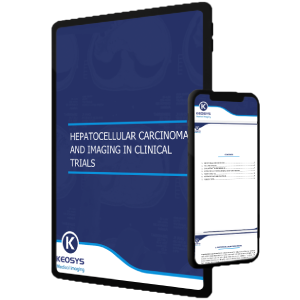This is an excerpt from our free eBook, “Hepatocellular Carcinoma and Imaging in Clinical Trials.” To access the full eBook, click here.
Selective internal radiation therapy (SIRT), also called Transarterial Radioembolization (TARE), is a transarterial treatment to deliver a tumoricidal dose to the tumor using Yttrium-90 radioisotope (90Y) embedded in glass microspheres (Therasphere®) or resin microspheres (SIR-sphere®) or using holmium-166 (166Ho) microspheres (QuiremSpheres®). This technique capitalizes on the fact that HCC is primarily fed by the hepatic artery, whereas the surrounding liver parenchyma receives its main supply from the portal venous circulation.
In SIRT, microspheres are mainly delivered into the tumor’s hepatic terminal arteries where the radioisotope particles emitting high-energy beta rays induce direct cytotoxic destruction. Since the beta rays have a mean and maximum penetration of approximately 2.5mm and 10mm respectively, a high dose can be delivered to tumors with limited toxicity to the rest of the liver. This is something important as external radiotherapy is not widely used due to the severe liver toxicity it may cause.
As explained by Dr. Yan Rolland, Head of the Diagnosis and Interventional Radiology Department at Centre Eugène Marquis, in Rennes, France, "It is necessary to target the tumor and avoid irradiation of the non-tumoral liver. That's why external radiation therapy is difficult to use in these pathologies. You cannot focus the beam enough to deliver treatment to the tumor without affecting an important volume of non-tumoral liver. Treatment through the vessels solved this problem because the lesions are hypervascularized, so this is the best way to deliver a high dose where you want it." More from our interview with Dr. Rolland can be found here.
-1.png?width=1204&name=Screenshot%20(81)-1.png)
The SIRT procedures are carried out by an interventional radiologist (IR) who places a catheter percutaneously via a patient’s femoral or radial artery and guides it to the hepatic artery (Figure 4).
- A dosimetric angiography is required to ensure patient eligibility, to maximize the tumor targeting, and to calculate the activity to be delivered to the tumor and non-tumoral liver:
- Angiography is acquired to assess hepatic vasculature, evaluate tumor-perfusing vessels, select the optimal catheter position to maximize the tumor dose and detect the presence of extrahepatic blood flow to other organs. This is a key step as there are many variations of the hepatic vascular system that can lead to complications. It is also essential to identify all blood supply to the tumor(s), as incomplete reporting can lead to incomplete targeting and treatment.
- 2D acquisitions and cone beam CT are both used during the dosimetric angiography to determine the best position of the microcatheter tip in order to target the tumor and provide additional information on liver perfusion.
- After consensus on catheter position between the IR and the nuclear medicine physician, Technetium 99m (99mTc) macroaggregated human albumin (MAA) is infused immediately, followed by nuclear scanning. 99mTc-MAA distribution is used as a surrogate marker for radiation dose.
- SPECT/CT allows an accurate delineation and precise measurements of delivered radioactivity. Tumor-to-normal liver uptake ratio is a key factor used to calculate radiation doses to the tumor and non-tumoral liver.
- Planar images are used to assess pulmonary shunting. Lung shunting fraction (LSF) estimates the total microsphere deposition within the lungs and quantifies the risk of developing radiation pneumonitis.
- A therapeutic angiography is performed one or two weeks later with radioactive microspheres infused in the same position. Post-treatment imaging is acquired directly after treatment to evaluate the beads distribution with Bremsstrahlung SPECT/CT. With 90Y PET/CT, the nuclear physician also checks the distribution of the microspheres and is able to measure the administered dose.
After treatment, during the follow-up period, tumor response is evaluated by CT/MRI[13]. Visualisation of the anti-tumor effects is delayed, optimal from six months onwards. The first monitoring is therefore often carried out at three months after treatment, then every three months. With SIRT, there are many findings related to the procedure itself that need to be considered such as inflammation, rim enhancement, or hepatic fibrosis with portal hypertension. In case of lobar treatment, delayed atrophy can occur, associated with contralateral lobe volumetric hypertrophy.
These post-therapeutic data and clinical outcomes should be correlated with delivered doses in order to optimize patient selection and technical issues. Recently, a comparison of standard dosimetry with personalised dosimetry showed a significant improvement of the objective response rate and clinical outcomes in patients with locally advanced HCC[14], which is important to note. As Dr. Yan Rolland observed, "There are two parts in the technique: One part is you do scintigraphy, and then you can calculate the dose. If you can't achieve a good dose, that’s a contraindication."
As immunotherapy with atezolizumab plus bevacizumab represents the new standard of care in systemic front-line treatment of HCC[15], these results should be confirmed by future studies combining modern SIRT concepts with systemic therapies.




